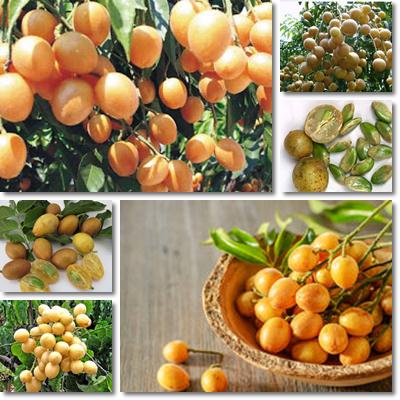The fruit of the evergreen Clausena wampi (also Clausena lansium) tree species, wampee, is not only a sweet and sour delight, but also a great source of antioxidant flavonoids with excellent anti-inflammatory, anticancer and anthelmintic properties.
The Clausena lansium species belongs to the same family as oranges, grapefruits, lemons and limes and is characterized by medium to very tall evergreen trees with smooth, bright green, slightly elongated and pleasantly scented leaves. Trees bloom in late March and produce generous amounts of edible, grape-like fruit. Depending on the variety and growing conditions, fruit may be more or less sour.
What does wampee look like?
Wampee are oval, 2-3 cm long, grape-like fruit with a slightly fuzzy and thin, but hard skin. Unripe wampee have a yellow-colored skin with patches of lime-green, while ripe ones have a rich golden-yellow color overall. The flesh is a translucent yellowish-white and looks a lot like litchi flesh. Each fruit has two or more bright green seeds that take up almost half of the fruit’s inside.

What does wampee taste like?
The taste of wampee fruit depends a lot on cultivar, growing conditions such as climate, soil, etc. For this reason, some people describe the fruit as being more sour than sweet, even resinous in taste, while others find it has a peach-like sweetness and a very pleasant citrussy acidity to it. Generally, wampee is both acidic in taste (it is, after all, related to citrus fruit), and sweet. The flesh has a juicy, lychee-like consistency and will leave your fingers a bit sticky after handling it due to the fruit’s natural sugar content.
What is wampee good for?
While it may not be an imposing presence in the fruit world, wampee does have several quite impressive health benefits that stem from its generous antioxidant, vitamin and mineral content. Consuming wampee on a regular basis can provide antioxidant protection, exert a strong anti-inflammatory action and even exhibit anticancer and anthelmintic properties. Find out below what are the most surprising 5 health benefits of wampee.

What are the benefits of eating wampee?
Rich flavonoid content
According to existing research, wampee fruit boast a rich flavonoid content. Flavonoids are natural yellow plant pigments with visibly potent antioxidant properties. The flavonoids in wampee help prevent extensive free radical damage known as oxidative stress, contributing to cellular health and offering antitumor protection. The predominantly sour taste of the fruit is also indicative of a high vitamin C content (148 mg of vitamin C per 100 g of fruit), an extremely potent natural antioxidant.
Anti-inflammatory action
According to recent in vitro studies, the bark of the Clausena lansium species was shown to possess excellent anti-inflammatory properties. In this sense, traditional Chinese medicine recommends infusions made from the dried bark and roots of the species for the treatment of the common cold and not-so-virulent influenza strains. As a result of its high vitamin C content, the fruit also boasts anti-inflammatory, antimicrobial and immunity-boosting properties.
Anthelmintic properties
Ongoing research is studying the potency of the anthelmintic properties of wampee fruit. Apparently, the fruit exerts an anthelmintic action and can incapacitate some types of intestinal parasites, facilitating their elimination together with bowel movements.
Anticancer potential
According to research, wampee peel possesses quite potent antitumor properties in the sense that it appears to inhibit the proliferation of cancer cells and, consequently, tumor growth. Its potency is comparable to that of a class of chemotherapy and anticancer medication known as cisplatinum (Journal of Biomedicine and Biotechnology, Volume 2009 (2009), Article ID 612805, link: http://dx.doi.org/10.1155/2009/612805).
Good for dandruff
Last but not least, decoctions made from wampee leaves appear to help treat dandruff problems. In addition to relieving scalp stress leading to irritation, redness and the shedding of excessive amounts of dead scalp cells (a.k.a. dandruff), the decoction helps manage oily, greasy hair better and leaves your hair smelling citrussy and fresh. But however efficient this remedy may be for some of us, it isn’t guaranteed to work for everyone. Still, being 100% natural, it might be worth giving it a try.
Conclusion
Overall, wampee is a healthy fruit and a fresh, sweet and sour taste experience. Existing research has managed to prove it holds several surprising health benefits, thus encouraging consumption greatly. If you are lucky enough to have the fruit grow near where you live, don’t hesitate to eat it as often as possible. Growing it yourselves might even lead to you getting sweeter, more delicious varieties that you might enjoy more.
